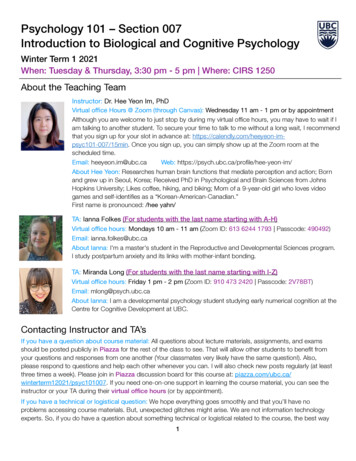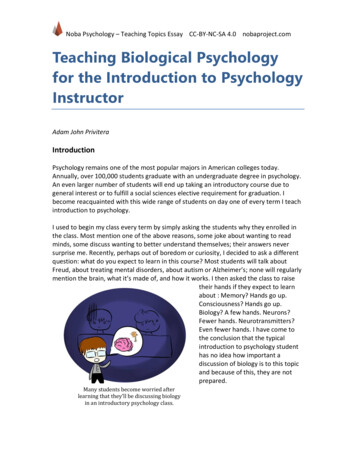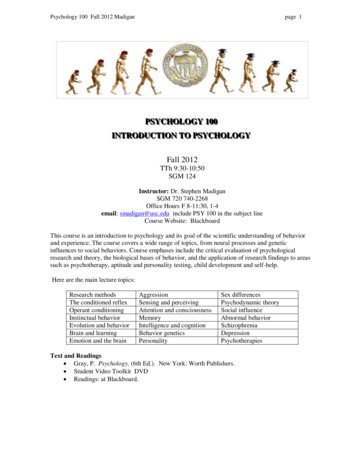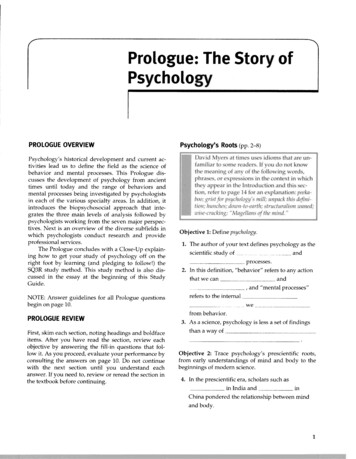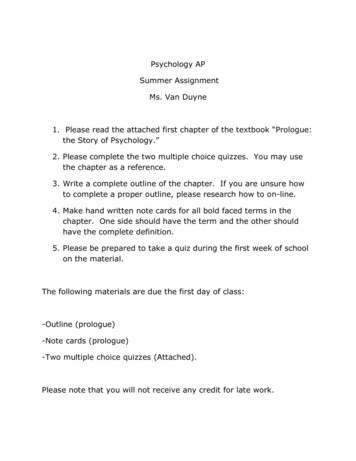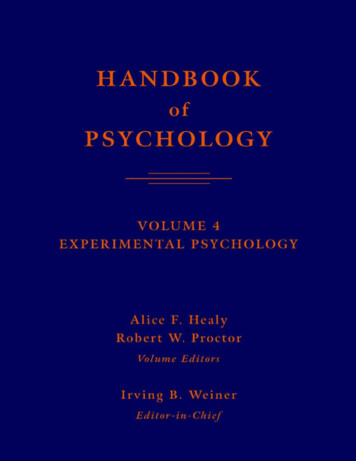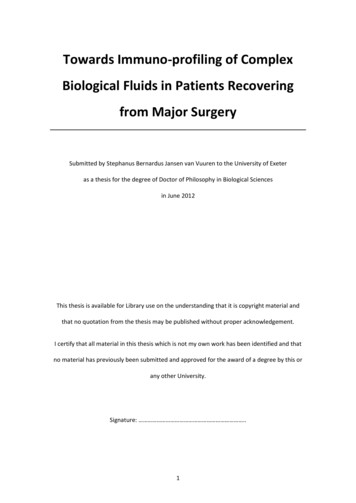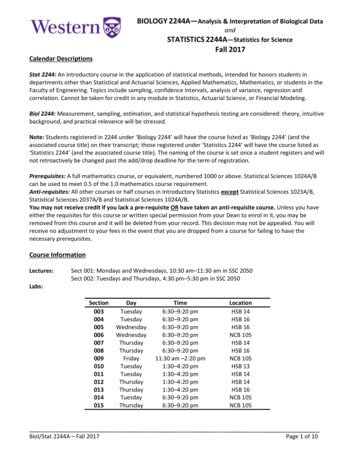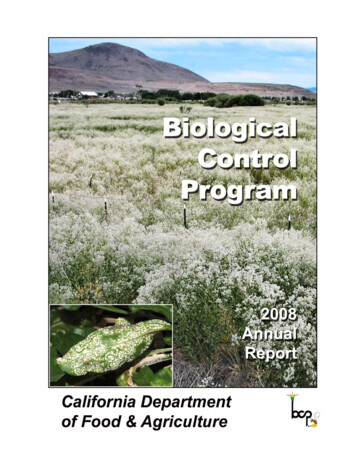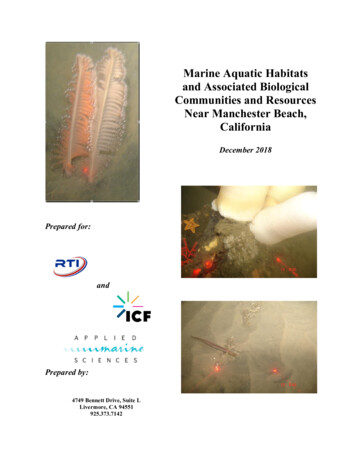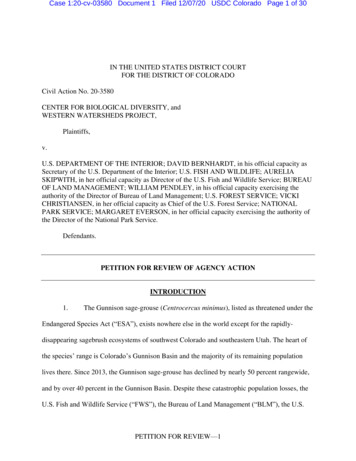
Transcription
Biological PsychologyTo know the brain.is equivalent to ascertaining the materialcourse of thought and will, to discovering the intimate history oflife in its perpetual duel with external forces; a historysummarized, and in a way engraved, in the defensive neuronalcoordinations of the reflex, of instinct and of the association ofideas.Santiago Ramon y CajalRecollections of My Life1Biological Psychology:IntroductionDr. Katherine Mickley SteinmetzWebsite: es.html2
Course Structure Exam 1 – Anatomy, Structure, & Functionof the nervous systemExam 2 – Interactions with the Environment:Sensory Systems & Homeostatic SystemsExam 3 – Cognitive Neuroscience:Emotion, Learning & Memory, LanguageFinal Exam – Neuroscience Disorders:Autism, ADD, Depression, OCD, Anxiety,Schizophrenia, and Alzheimer’s Disease3Introduction to BiologicalPsychology NeuroscienceResearch Neuroscience History Monism vs. Dualism What can modernneuroscience tell us?
Introduction to BiologicalPsychology NeuroscienceResearch Neuroscience History Monism vs. Dualism What can modernneuroscience tell us?The Grand Challenges forNeuroscience in the 21st CenturyInstitute of Medicine - 2008 How does the brain work and producemental activity? How does physical activity in the brain lead tothought, emotion, and other behaviors?Nature and nurture: How does the interplayof biology and experience shape our brainsand make us who we are today?How do we keep our brains healthy? How do we protect, restore, or enhance thefunctioning of our brains as we age?6
Neuroscience Research Human & animal studies What are the benefits of each?7The nervous system is remarkably similarbetween humans and other animals.8
Strict guidelines regulate the use ofanimals in researchAt WOFFORD:Animal Care and Use Committee: Veterinarian, Non-Scientist, Non-Affiliatedwith Wofford, Scientists both conductingand not conducting research Inspects all areas where animals arehoused or tested Reviews and approves every researchprotocol using animals on campus9Introduction to BiologicalPsychology NeuroscienceResearch NeuroscienceHistory Monism vs. Dualism What can modernneuroscience tell us?
Neuroscience HistoryHippocrates: The brain is thesource of intellect Galvani & du Bois-Reymond:Nervous system communicates byelectricity Ramon y Cajal: nervous system iscomposed of separate cells 11Question?Is your person (personality) in yourbrain? Are you your brain? Mind - body issue. What can neuroscience tell us about thisquestion?12
Dualism Rene Descartes’experiencesDualism: Humans physicalbodies and nonphysical minds, orsouls Mind is not physical,so it can’t be studiedDualism Mind and brainare 2 distinctphenomenaMind can controlphysical objects(through pinealand brain)
Dualism Free will: We can choose to do what we wish Mind is not constrained by body Mind tells brain what to do15Monism Hippocrates: believed that mindwas a function of thebrain’s physiologicalprocesses Mind and body areboth biologicalphenomena
Monism Mental states are just physiological statesof the brainMind is a phenomenon produced by theworkings of the body – emerging from brainIf we could fully understand the workings ofthe body, we could understand mind/soul aswell as how we think, perceive, rememberand act.17MonismDeterminism: Behavior is caused byprevious physical events andenvironmental influences. Free will: is a myth bolstered by thecomplexity of human brain and ourown self-awareness that makes usfeel like our minds control our bodies. 18
Free Will Video19http://www.youtube.com/watch?v fI1624SwYnI&feature relatedMind-Body QuestionWho’s right?Monists? Dualists?Data from this course can speak to thisquestion Examples: Phineas Gage Split brain patients Prefrontal Lobotomy20
Phineas GageDynamite worker using a steel rod toram a charge into a hole Charge exploded and sent rodthrough his cheek/orbitofrontal cortex 21Phineas Gage What’s it like to have a 1.25-inch diametertamping iron blasted through your head?
The rod that went throughGage’s Brain23Phineas GageComputer reconstruction
Phineas GageComputer ReconstructionPhineas Gage Personality changes Before: serious, industrious, energetic After: Childish, irresponsible, thoughtless,unable to carry out plans, capricious26
Generalizations from similarcases Damage to orbitofrontal cortex: Reduces inhibitions Persons become indifferent Pain no longer bothered them(indifference)27Split Brain Individuals Corpus CallosumcutRight and lefthemisphere notcommunicatingVery differentpersonalities in eachhemisphereWhere is the“person”?28
Split Brainhttp://www.youtube.com/watch?v PFJPtVRlI6429Prefrontal LobodomyAnimal studies: Jacobsen, Wolfe andJackson (1935). Becky the chimp Frontal lobe removal reduced frustrationreaction and violent behaviors Egas Moniz: Nobel Prize (1949) Walter Freeman: http://www.youtube.com/watch?v 0aNILW6ILk Could one reduce anxiety and frustrationsurgically? 30
Prefrontal LobotomyTransorbital leucotomePatients could have lobotomy in Dr’s OfficePrefrontal LobotomyTens of thousands done in 50s - 70s Trans-orbital leucotome Results: Reduced violent behaviorsIrresponsible and childlikeUnemployableDifferent personality32
Question?Is your person (personality) in yourbrain? Are you your brain? Mind - body issue. What can neuroscience tell us about thisquestion?33Please share your thoughts 1.2.3.4.Name (Phonetic Spelling)What do you hope to get out of this class?Do you have any neuroscience experience(personal or academic)? If so, what?What do you think will be the mostchallenging about this class? What are youmost excited about?34
For Next Time Read Chapter 2: Neuroanatomy Lab Tomorrow: Week 1 Structures Lab Practical Review the names and Human Plates Spelling Counts!35
Biological Psychology To know the brain.is equivalent to ascertaining the material course of thought and will, to discovering the intimate history of life in its perpetual duel with external forces; a history summarized, and in a way engraved, in the defensive neuronal coordinations of
